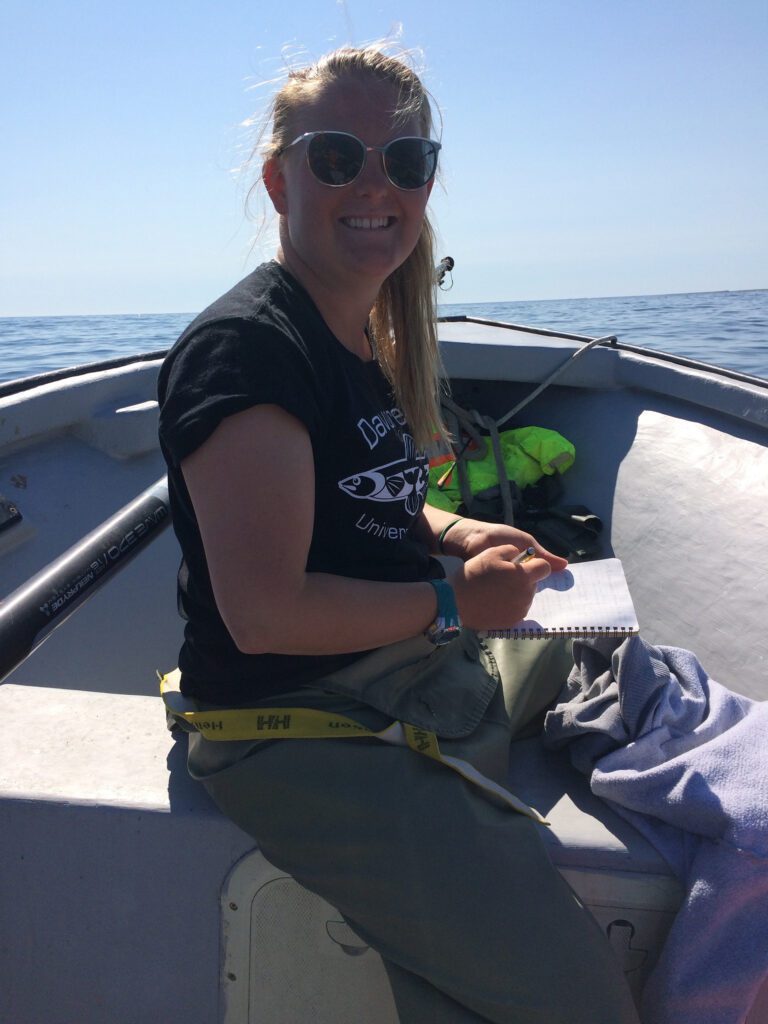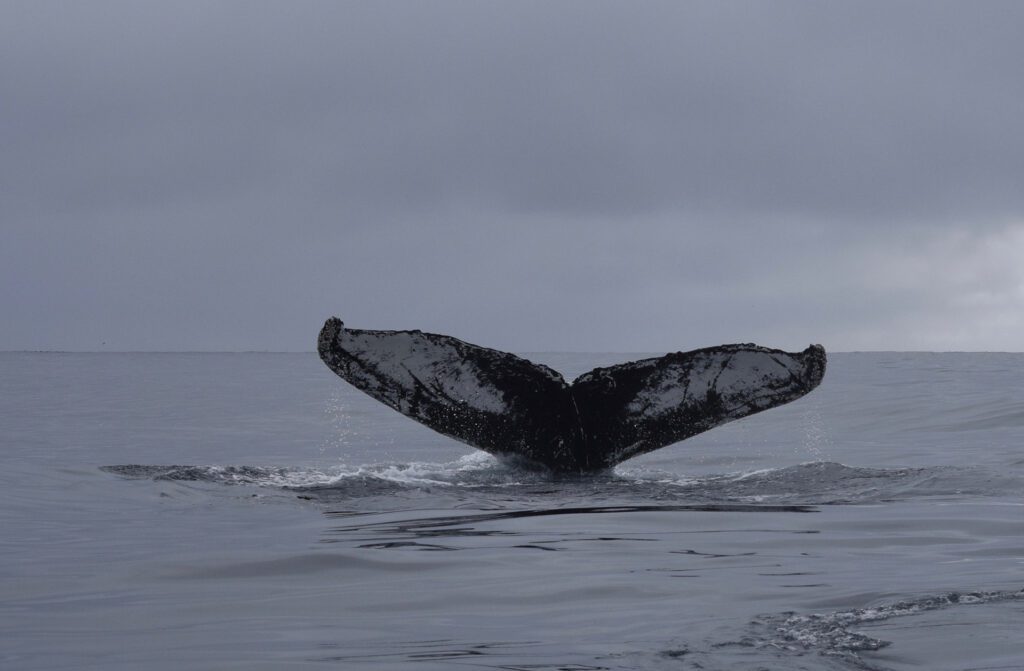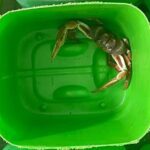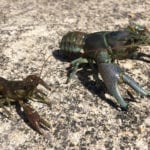At a mass of 30,000 kg—or about 16 cars—the humpback whale must have a massive appetite to satisfy. What do these blubbery giants eat when hunger strikes?
 For her graduate research at the University of Manitoba, Kelsey Johnson traveled to the northeast coast of Newfoundland to study the dietary habits of humpback whales. Using field-collected tissue samples and stable isotope techniques, Kelsey’s research—in collaboration with Professor Gail K. Davoren—confirmed that capelin are the primary prey humpback whales eat, even decades after stocks of this forage fish collapsed. The study—published in the Canadian Journal of Zoology and selected as July’s Editor’s Choice—is also a reminder of the importance of concurrently collecting samples from predator and prey.
For her graduate research at the University of Manitoba, Kelsey Johnson traveled to the northeast coast of Newfoundland to study the dietary habits of humpback whales. Using field-collected tissue samples and stable isotope techniques, Kelsey’s research—in collaboration with Professor Gail K. Davoren—confirmed that capelin are the primary prey humpback whales eat, even decades after stocks of this forage fish collapsed. The study—published in the Canadian Journal of Zoology and selected as July’s Editor’s Choice—is also a reminder of the importance of concurrently collecting samples from predator and prey.
Kelsey recently shared details with Dick Bourgeois-Doyle about her paper, Stable isotope analysis reveals that humpback whales (Megaptera novaeangliae) primarily consume capelin (Mallotus villosus) in coastal Newfoundland, Canada
Listen to the interview with Kelsey Johnson or read the interview below:
Thanks a lot Kelsey for taking time to talk about your research. I have to say a first question that came to mind in reading your paper was “Why Manitoba?”. Why did the University of Manitoba take a special interest in humpback whales and capelin and the northeast coast of Newfoundland, and I guess by extension yourself personally.
That is a valid question, and we get that question a lot when we’re working in Newfoundland.
So this was through my master’s project that this paper came out, and I met my supervisor Gail [Davoren] during my undergraduate degree at the University of Manitoba. She had a long term study site in Newfoundland during her PhD, she did her PhD in Newfoundland. And so she just kept her long term study site when she got hired at the University of Manitoba. So, it’s a great opportunity for prairie students to a chance to work in a marine environment.
So you were a biology student to begin with and looking for something to do in your master’s program and Gail was there with her interests in this marine environment?
Yeah, well, so actually I ended up getting on for my honours during my undergrad to study capelin. So, I stared off studying capelin with her lab and that gave me a chance to go out in the field, and realized I loved it. It also gave me a chance to realize that there’s humpback whales everywhere presumably foraging on capelin. And Gail had done a lot of work with sea birds and capelin. But she hasn’t done much work with the humpback whales yet. So, I saw it as an opportunity to really gain a wide range of experience: kind of creating a project, figuring out the logistics of the project, and actually conducting the data collection for the project. So, I got to spearhead this whole new humpback whale project which is really exciting.
I found it a little surprising since the capelin stock basically crashed in early 1990s to read in your paper and elsewhere that a study of this nature had not been done in the 20 years that had passed. Is there any particular reason for that?
I think that there is a lot to study in the Newfoundland marine ecosystem: a lot of people are focusing on the capelin, a lot of people are focusing on the cod, and this humpback whale population that I am studying, the humpback whale that comes to forage off Newfoundland, they seem to be doing alright so there’s no alarming changes, I believe, after that crash. And so there is no big need necessarily to study that. However, I think it’s great to study populations when they’re doing well so we have a baseline of what we can compare.
I guess it’s also good to test your assumptions because I gather people were assuming they were eating herring and was it sand lance that was the other possibility?
Well, so the thing is that people didn’t necessarily know. And most people are actually assuming that they were eating capelin just because previous studies had [conveyed]—“oh humpbacks are here, and capelin are here, therefore humpbacks must be eating capelin,” which is probable but there was no quantitative evidence of that. And so this is a great paper that people can cite that actually says yes capelin are a large part of the humpback whale diet.
It would be great if you could talk a bit about the technique of the analysis of the stable isotopes in the skin and the body of the humpback whales. But I wonder if you could just talk about the experience of actually collecting the samples out in the field. I guess you had people shooting darts into the whales?
So, I actually got to do all that myself which was exciting and nerve-racking all at the same time cause Gail hadn’t done much marine mammal work at all. I really got to start the project from the beginning.
I was figuring out how are we actually going to this: all the steps we had to take and all the logistics with that. And so I was responsible for getting the crossbow, becoming comfortable with the crossbow, practicing a lot and then I was able to go out and be the one to collect the skin samples. You use a crossbow that has a dart that has a special hollow tip that punctures the whale’s skin in a very small amount so the whale typically doesn’t show any reaction at all to the biopsy. They can continue on their way.
Of course, the project would have gone through an animal care committee.
Of course, yep, and so everything goes through the animal care committee. We have very strict rules we have to follow when going to collect samples in regard to how close we get, how long we work with one animal and that sort of thing.
People who work with whales and marine mammals I guess would know this well, but I found interesting about your ability to actually identify each whale. I don’t think you’re able to do 100% of the whales, sort of correlate an identify of the whale with the sample. But yeah it’s kind of neat I wonder if you could talk a bit about how you do that.
Yeah, so humpback whales have a unique pattern on ventral side of their flute, and so its typically a white and black pattern. And they’re like a thumb print for each humpback so you can identify individuals over the years. They do change as they get older but not significantly. There will still be those similar markings that you can refer back to and so that way we’re able to ensure we didn’t biopsy the same individual the same year. We were able to say that these humpbacks came back to this one small capelin spawning ground like year after year after. So, it indicates its an important foraging ground for them.
 When you’re doing the analysis of the stable isotopes in the skin samples your first round of analysis kind of suggested that there wasn’t as big of a capelin consumption activity going on there as you initially assumed so you had to jump and do an analysis of the capelins. Is that correct?
When you’re doing the analysis of the stable isotopes in the skin samples your first round of analysis kind of suggested that there wasn’t as big of a capelin consumption activity going on there as you initially assumed so you had to jump and do an analysis of the capelins. Is that correct?
That is correct. So, the first way we analysed this was using a program called Cyber that is basically just plotting the humpback whale stable isotope data and looking at the dietary niche breath and so when I plotted 2016 and I plotted 2017 there is very minimal overlap between them. This originally led me to believe that “oh, they’re eating different things those two years.” And fortunately, we had collected potential prey samples both those years and were able to plot that in and see that the prey also has a similar shift between years as the humpbacks did. And so, when we put all of this stable isotope data in the predator humpback whale’s data and the prey stable isotope data into MixSiar, which is a program that constructs the dietary proportions and can see that they’re actually eating almost ninety percent capelin for both years and that’s very interesting.
So that would suggest or at least to me maybe could confirm my perception that it’s really important when doing this kind of dietary analysis that you also a couple it with an analysis in data collection of the prey and would not be applicable no matter what animals you’re looking at land animals.
Yeah, we were definitely not the first study to show this, but we reiterate that it’s important to collect the potential prey that properly represents the diet of the animal you are studying in the year or the time they are foraging—properly collect prey that would represent the predator’s diet.
So, I understand you are now pursuing a career with the Department of Fisheries and Oceans, and I think you said you’re interested in policy—that’s great—thanks for doing that for Canada. But do you see yourself being involved in further studies like this—scientific projects—or do you see others developing what you’ve learned here?
So, right now Gail, myself and another researcher are finishing up the analysis of a next step we took in this dietary study was some multi-sensor tagging of humpback whales and so we tagged them with these tags that will also record video of them underwater and their movements. And so I guess the next step will be to actually have how they worked on the capelin and visual confirmation that they are foraging on capelin is great. And yes, I am dipping my toes in policy right now just to see if I do like it. And I don’t know I’ll go back though there’s a potential to continue this. But I would be very happy for anyone to continue this research. I think it’s really important to study these humpback whales in Newfoundland (because) there is not a lot has been done on it.
I don’t think many would argue that we don’t need more people with a science bent in policy development in Canada. So good luck with that.
Thank you so much.




